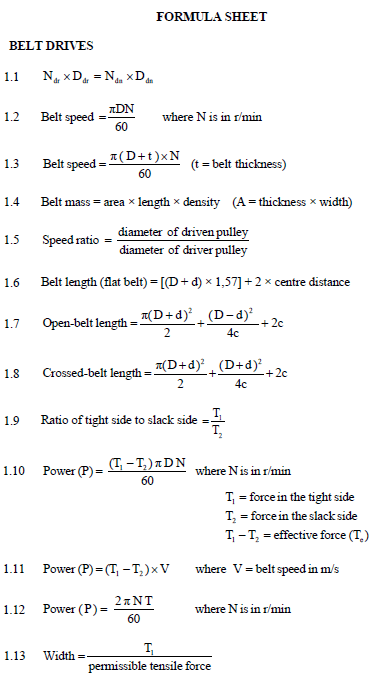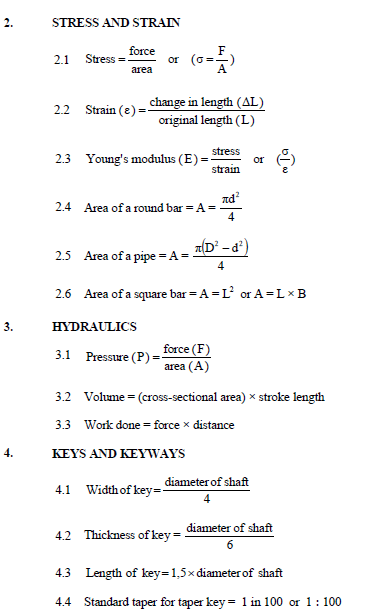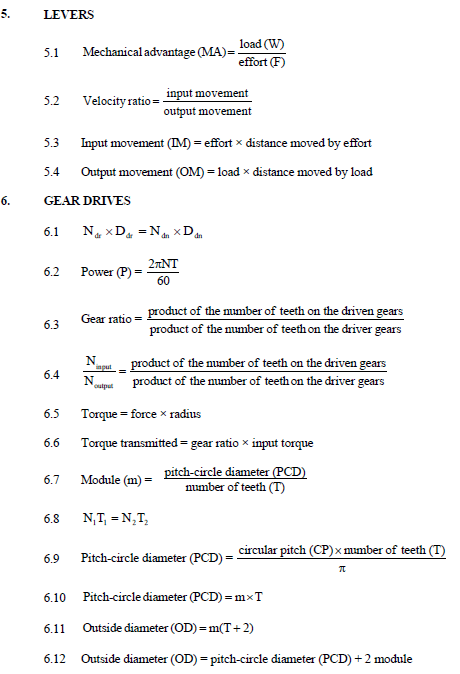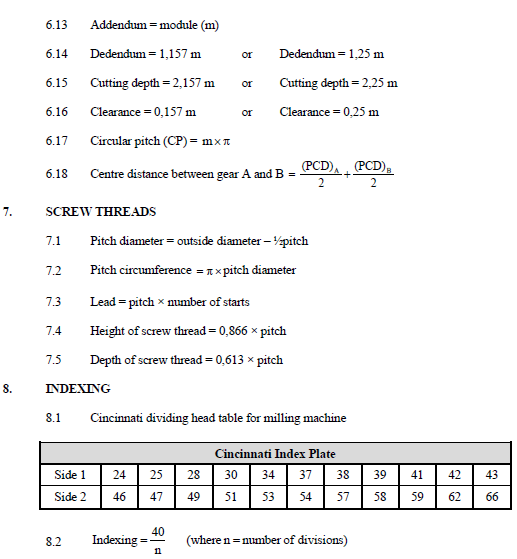MECHANICAL TECHNOLOGY GRADE 12 QUESTIONS - NSC PAST PAPERS AND MEMOS SEPTEMBER 2017
Share via Whatsapp Join our WhatsApp Group Join our Telegram GroupMECHANICAL TECHNOLOGY
GRADE 12
NSC PAST PAPERS AND MEMOS
SEPTEMBER 2017
INSTRUCTIONS AND INFORMATION
- Write your name on your ANSWER BOOK.
- Read ALL the questions carefully.
- Answer ALL the questions.
- Number the questions correctly according to the numbering system used in this question paper.
- Start EACH question on a NEW page.
- Show ALL calculations and units. Round off final answers to TWO decimal places.
- Candidates may use non-programmable scientific calculators and drawing instruments.
- Take the value of gravitational force as 10 m/s2.
- All dimensions are in millimetres, unless stated otherwise in the question.
- A formulae sheet for your use is attached at the back of this question paper.
- Write neatly and legibly.
- Use the criteria below to assist you in managing your time.
QUESTION | CONTENT COVERED | MARKS | TIME (MINUTES) |
1 | Multiple-choice | 20 | 15 minutes |
2 | Safety | 10 | 10 minutes |
3 | Tools and equipment | 12 | 10 minutes |
4 | Materials | 13 | 10 minutes |
5 | Terminology | 30 | 20 minutes |
6 | Joining methods | 25 | 25 minutes |
7 | Forces | 30 | 30 minutes |
8 | Maintenance | 15 | 15 minutes |
9 | Systems and control | 25 | 25 minutes |
10 | Turbines | 20 | 20 minutes |
TOTAL | 200 | 180 minutes |
QUESTIONS
QUESTION 1: MULTIPLE-CHOICE QUESTIONS
Choose the correct answer from those indicated by A, B, C or D and write your choice next to the question number IN YOUR ASWER BOOK.
1.1 Which ONE of the following statements is a basic rule for safe handling of a hydraulic press?
- Make sure the work piece is sturdily in position
- You may exceed the recommended pressure
- Worn-out supports may be used
- Use a hammer to get the work piece into position (1)
1.2 What safety measure is applicable to the centre lathe in terms of the Occupational Health and Safety Act, 1993 (Act 85 of 1993)?
- All surfaces of the machine must be well oiled.
- Guards could be removed when cutting material.
- Do not do any adjustments while the machine is running.
- Always ensure that measuring instruments are available. (1)
1.3 The following apparatus is used on a milling machine to divide a work piece into even divisions:
- Machine vice
- Dividing head
- Compound slide
- Change gears (1)
1.4 What is a function of a multi-meter?
- To determine the forces in materials
- To analyse materials
- To test electrical circuits
- To analyse the air fuel mixture (1)
1.5 Which ONE of the following is a property of cementite?
- It is ductile
- It is weak
- It is malleable
- It is hard and brittle (1)
1.6 When plain carbon steel is heated at a uniform rate, its temperature rises evenly to 700 °C. The temperature then remains constant for a while. This point is called the …
- recalescence point.
- cooling point.
- decalescence point.
- higher critical point. (1)
1.7 Which ONE of the following is an advantage of down-cut milling?
- Vibration experienced is less.
- Coarse feed may be used.
- The finish obtained is finer.
- The strain on the cutter and arbor is less. (1)
1.8 Which lathe operation is shown in FIGURE 1.8?
| FIGURE 1.8 |
- Parting
- Parallel turning
- Internal parallel boring
- External thread cutting (1)
1.9 What is the name of the series of pulleys with attached rope or chain, as shown in FIGURE 1.9?
| FIGURE 1.9 |
- Wheel and axle
- Block and tackle
- Stepped pulley and idler
- Open-belt system (1)
1.10 Which ONE of the following tests is a destructive test?
- X-ray test
- Dye penetration test
- Nick-break test
- Ultrasonic test (1)
1.11 Shielding the arc and molten pool from atmospheric gases is the function of the …
- inert gas.
- outlet gas
- inlet gas.
- air-fuel mixture. (1)
1.12 What is understood with the term Young's modulus of Elasticity?
- The force value required to produce a unit area in a tensile test specimen
- The ratio between stress and strain in a metal, provided that the limit of elasticity is not exceeded
- A measurement of the extension or contraction of material due to the load experienced
- A ratio of the deformation because of the application of an external force (1)
1.13 The unit for strain:
- Is newton
- Is pascal
- Is watt
- Has no unit (1)
1.14 Which ONE of the following is the purpose of lubrication?
- To reduce friction
- To reduce wear
- To prevent corrosion
- All the above-mentioned (1)
1.15
| FIGURE 1.15 |
SAE 20W50 oil, as illustrated in FIGURE 1.15 above, is used for …
- engine lubrication.
- gearbox lubrication.
- differential lubrication.
- automatic gearbox lubrication. (1)
1.16 Which ONE of the following is a function of a friction clutch?
- It supports light radial loads.
- It transmits power at high speeds.
- It supports high-pressure loads.
- It carries a combination of radial and axial thrust loads. (1)
1.17 FIGURE 1.17 shows three gears meshing.
| FIGURE 1.17 |
What is Gear B called?
- Helical gear
- Rack
- Idler gear
- Pinion (1)
1.18
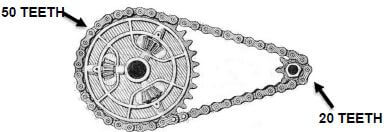 |
| FIGURE 1.18 |
Determine the speed ratio of a racing cycle that uses the chain and sprocket system as shown in FIGURE 1.18 above.
- 2,5 : 1
- 0,4 : 1
- 25 : 25
- 25 : 1 (1)
1.19 Which ONE of the following classifications of turbines is used for internal combustion engine applications?
- Turbocharger
- Roots blower
- Centrifugal blower
- All the above-mentioned (1)
1.20 Choose the advantage of a turbocharger over a supercharger from the following options:
- The turbocharger makes use of diesel to operate.
- The turbocharger makes use of exhaust gases (waste) to operate.
- The turbocharger makes use of petrol to operate.
- The turbocharger makes use of an engine to operate. (1)
[20]
QUESTION 2: SAFETY
2.1 State the reason why oil and grease should never be used on or near the regulator of oxy-acetylene equipment. (2)
2.2 Name THREE safety precautions when handling or using the gas cylinders. (3)
2.3
| FIGURE 2.3 |
List TWO precautions you would take when welding using the MAGS/MIGS welding machine. (2)
2.4 Which safety precautions should be observed when working on the following parts of a lathe:
2.4.1 Tailstock (1)
2.4.2 Machine guard (1)
2.4.3 Chuck (1)
[10]
QUESTION 3: TOOLS AND EQUIPMENT
3.1 Name TWO devices that are used to test the hardness of a metal. (2)
3.2 Give THREE reasons for using a compression tester on an engine. (3)
3.3 State the function of a tensile tester. (2)
3.4 A gas analyser is an important piece of equipment as it is used to analyse the exhaust gases of an internal combustion engine. Give TWO reasons for a high CO reading. (2)
3.5 List THREE operating rules when using a multi meter. (3)
[12]
QUESTION 4: MATERIALS
4.1 Name the THREE groups of carbon steel and state the percentage carbon content range of each. (9)
4.2 Briefly explain what happens to steel when it reaches the AC1 line during the heating process. (2)
4.3 To what temperature is steel with a carbon content of 1% heated, for hardening? (2)
[13]
QUESTION 5: TERMINOLOGY
5.1 Milling cutters can be divided into two groups: according to design or method of sharpening. Name these TWO groups and also give TWO examples of each. (6)
5.2 Name TWO characteristics of a good milling cutter. (2)
5.3
| LATHE MACHINE |
| FIGURE 5.3 |
Explain the screw-cutting procedure using the compound-slide method in FIGURE 5.3 above. (7)
5.4 Thirty three (33) teeth must be milled on a gear wheel.
5.4.1 Which type of milling cutter can be used to machine the gear? (1)
5.4.2 Calculate the indexing needed. (3)
5.5
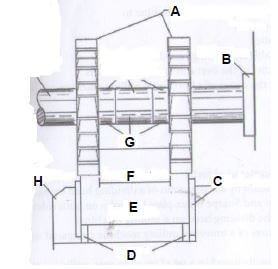 |
| FIGURE 5.5 |
Label the parts of the dividing head indicated in FIGURE 5.5 according to the letters A–H. (8)
5.6
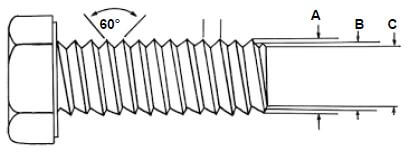 |
| FIGURE 5.6 |
Identify the THREE parts labelled A, B and C of a screw thread as shown in FIGURE 5.6 above. (3)
[30]
QUESTION 6: JOINING METHODS
6.1
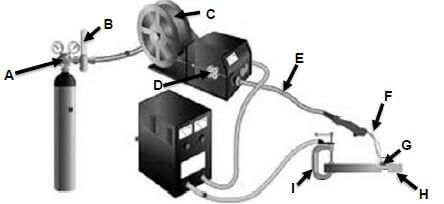 |
| FIGURE 6.1 |
Label the MIG-welding equipment indicated in FIGURE 6.1 according to the letters A–I. (9)
6.2
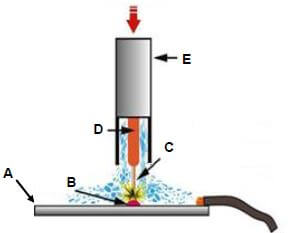 |
| FIGURE 6.2 |
Label the MIG-welding process indicated in FIGURE 6.2 according to the letters A–E. (5)
6.3 Name THREE non-destructive tests that can be performed on welded joints. (3)
6.4 Explain how the nick-break test is performed onto a weld. (4)
6.5 What is the purpose of inert gas with the MIG-welding process? (2)
6.6 After inspecting a weld, slag inclusion was discovered in the weld. Name TWO causes for this defect. (2)
[25]
QUESTION 7: FORCES
7.1 Define the following terms:
7.1.1 A force (1)
7.1.2 Forces in equilibrium (1)
7.1.3 Resultant of a system of forces (1)
7.2 A load of 40 kN causes a tensile stress of 20 MPa in a round brass bar. The original length of the bar is 800 mm and Young’s Modulus of Elasticity for brass is 90 GPa.
Calculate:
7.2.1 The diameter of the bar (6)
7.2.2 The strain (2)
7.2.3 The change in length (3)
7.3 FIGURE 7.3 indicates a system of forces with four co-planner forces acting onto the same point.
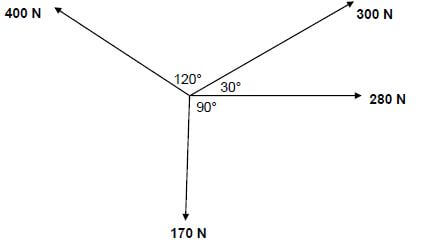 |
| FIGURE 7.3 |
Make use of calculations and determine the magnitude and direction of the resultant of this system of forces which is in equilibrium. (10)
7.4 FIGURE 7.4 indicates a uniform beam supported by two vertical supports, A and B. Two vertical point loads of 800 and 350 newton, and a uniformly distributed load of 80 newton per meter over the distance between the two supports, are exerted onto the beam.
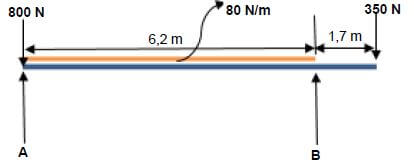 |
| FIGURE 7.4 |
Make use of calculations and determine the reactions in supports A and B while the beam is in equilibrium. (6)
[30]
QUESTION 8: MAINTENANCE
8.1 Describe in detail the effectiveness of cutting fluid as compared to oil when turning a work piece on a centre lathe. (3)
8.2 Describe what will happen if the engine oil in a vehicle is not changed regularly. (3)
8.3 Define the following:
8.3.1 Flash point (2)
8.3.2 Pour point (2)
8.4 Name THREE properties of grease. (3)
8.5 State TWO functions of a clutch plate and pressure plate in the clutch and pressure plate assembly. (2)
[15]
QUESTION 9: SYSTEMS AND CONTROL
9.1 The mechanical workshop need a hydraulic press. The diameter of Piston B is 180 mm and moves up by 12 mm. The force applied on Piston A is 550 N. Piston A moves 60 mm downwards.
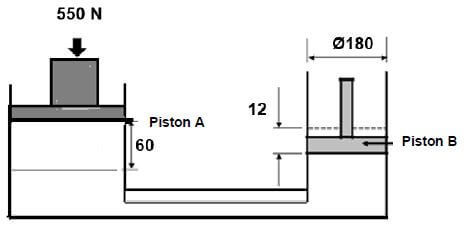 |
| FIGURE 9.1 |
Use the specifications shown in FIGURE 9.1 and calculate the following:
(Hint: VA = VB)
9.1.1 The diameter of Piston A (9)
9.1.2 The pressure exerted on Piston A (2)
9.1.3 The force exerted on Piston B (4)
9.2 A brass bush, 80 mm long with an inside diameter of 30 mm and an outer diameter of 40 mm, is used in a press to push out bearings. A force of 23 kN is exerted onto the bush.
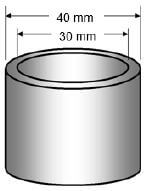 |
| FIGURE 9.2 |
9.2.1 Name the type of stress that the bush material is subjected to. (1)
9.2.2 Calculate the stress in the material. Indicate the answer in MPa. (5)
9.3 You are to design a gear drive for a mincing machine.
The shaft of the machine must rotate at 90 r/min.
On the electrical motor is a driver gear with 30 teeth that meshes in with a driven gear with 80 teeth on a counter shaft.
On the counter shaft is a second driver gear with 20 teeth that meshes in with the final driven gear which has 40 teeth.
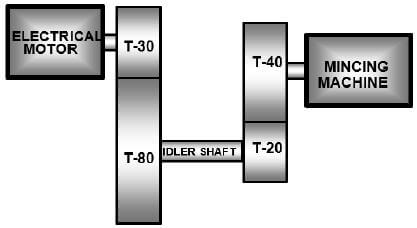 |
| FIGURE 9.3 |
9.3.1 Calculate the rotation frequency of the electrical motor. (2)
9.3.2 Name TWO advantages of a gear drive compared to a belt drive. (2)
[25]
QUESTION 10: TURBINES
10.1 State TWO purposes of a supercharger. (2)
10.2 Name TWO examples of where a supercharger is used. (2)
10.3 Turbochargers are used in heavy vehicles to increase the engine power output.
Explain the principle of operation of the turbocharger. (8)
10.4 Explain the basic operation of a steam turbine. (5)
10.5 Name THREE turbines other than the steam turbine. (3)
[20]
TOTAL: 200
